Can anything shut down the Gold rally?
Introduction & Market Context
Commerce.com (NASDAQ:BIGC), operating as BigCommerce, presented its Q2 2025 earnings on July 31, 2025, highlighting improved profitability and strategic positioning in the evolving e-commerce landscape. The company’s stock rose 5.44% to $5.04 in premarket trading following the results, suggesting positive investor reception despite ongoing challenges in the broader e-commerce sector.
The presentation emphasized BigCommerce’s transformation into an integrated commerce platform through strategic acquisitions and its positioning for what it terms the "Agentic Commerce Era" – the next evolution in digital commerce driven by AI agents and personalized experiences.
Quarterly Performance Highlights
BigCommerce reported solid financial improvements in Q2 2025, with a particular focus on profitability metrics. The company achieved a non-GAAP gross margin of 80% and turned its operating income positive, reaching $5 million compared to a $14 million loss in the same quarter of 2022.
As shown in the following performance highlights chart:
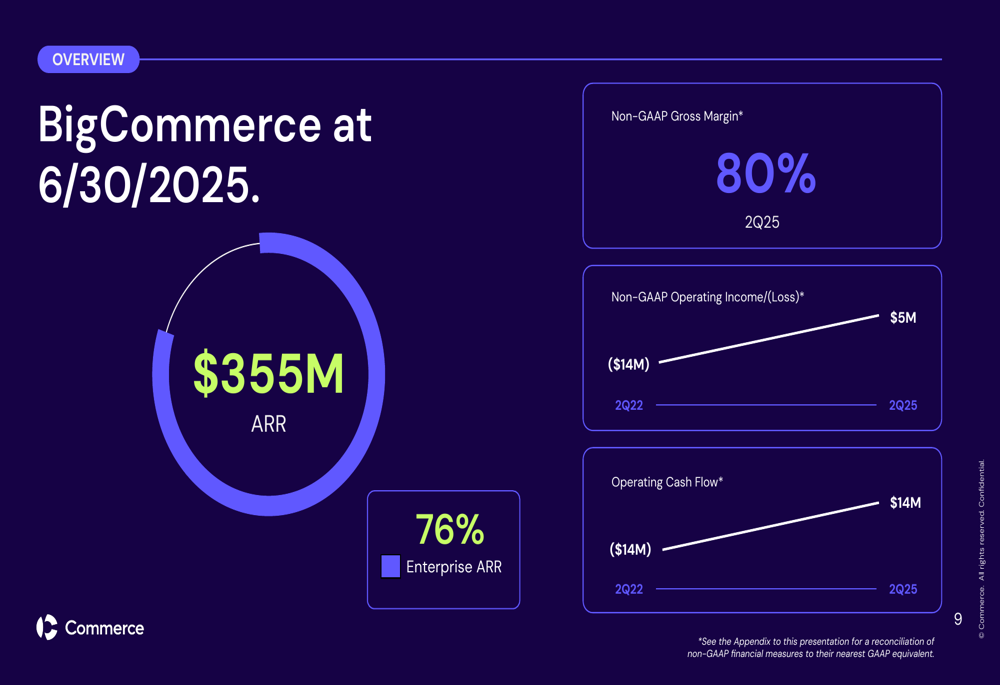
Annual Recurring Revenue (ARR) reached $355 million, with enterprise customers now representing 76% of the total. This enterprise-focused strategy has been central to BigCommerce’s growth narrative. Operating cash flow showed significant improvement, reaching $14 million in Q2 2025 compared to a negative $14 million in Q2 2022.
The company’s revenue growth has been steady, though showing signs of deceleration in recent quarters. Total (EPA:TTEF) ARR increased from $346 million in Q2 2024 to $355 million in Q2 2025, representing modest year-over-year growth.

This performance follows the company’s Q1 2025 results, where BigCommerce reported earnings per share of $0.07, beating analyst expectations of $0.05, with revenue of $82.4 million representing a 3% year-over-year increase.
Strategic Positioning and Acquisitions
BigCommerce has positioned itself as an end-to-end AI-optimized commerce stack through the integration of three key components: BigCommerce (commerce engine), Feedonomics (data orchestration), and Makeswift (storefront experience). This integrated approach aims to address both traditional commerce challenges and emerging opportunities in AI-driven commerce.
The company’s commerce stack is visualized in the following slide:
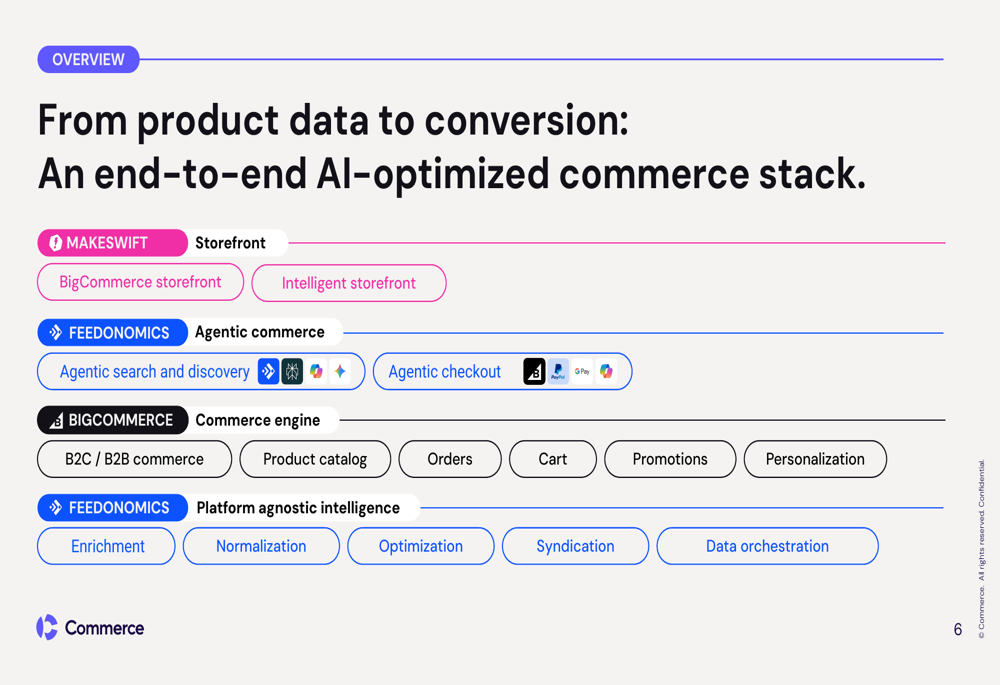
The presentation emphasized BigCommerce’s evolution through three distinct eras: the Omnichannel Era, the Composable Era, and now the Agentic Era. This progression has been marked by strategic acquisitions including Feedonomics, B2B Ninja, and Makeswift, which have expanded the company’s capabilities beyond its core commerce platform.
BigCommerce highlighted its investment appeal through several key factors:

The company’s strategic vision centers on being "built for businesses, ready for agents" – positioning itself to help merchants maintain control of their brand experience while adapting to emerging AI-driven commerce channels.
Enterprise Growth and B2B Focus
A significant highlight of the presentation was BigCommerce’s continued success in growing its enterprise customer base. Enterprise ARR has grown from $90 million in Q3 2020 (at IPO) to $269 million in Q2 2025, now representing 76% of total ARR compared to 46% at IPO.
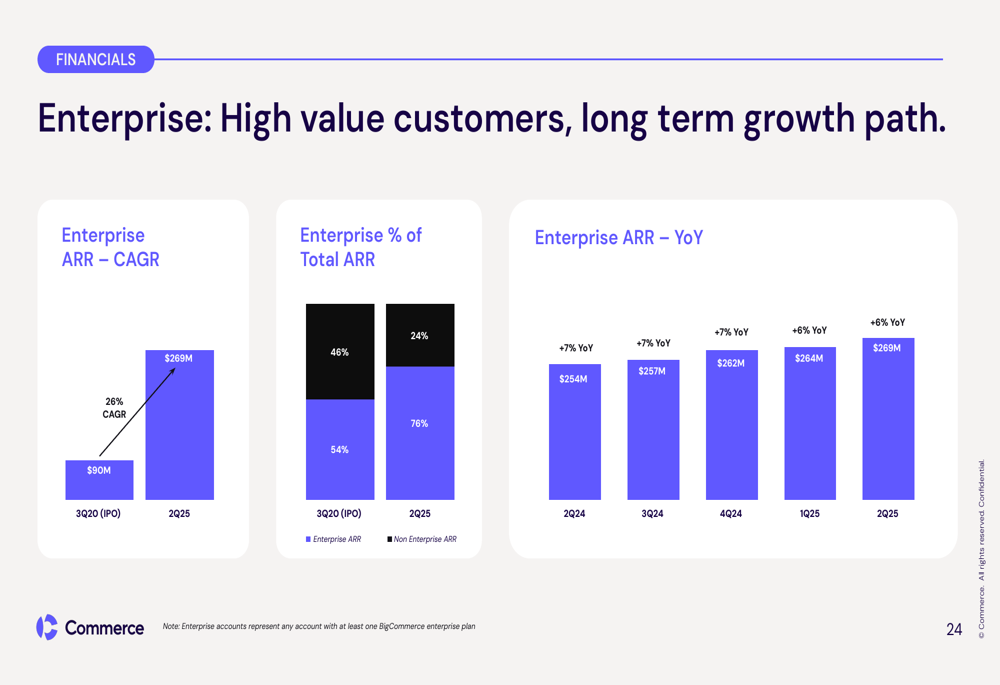
The company has placed particular emphasis on its B2B commerce capabilities, highlighting differentiated features such as multi-company hierarchy, configure-price-quote functionality, and support for enterprise-scale operations. According to the presentation, B2B brands using BigCommerce have experienced benefits including 24% more efficient sales teams and 391% ROI.
This B2B focus appears to be a strategic priority, with the company noting market leadership in modern B2B commerce as one of its key investment highlights. The emphasis on complex business models aligns with the company’s enterprise-focused growth strategy.
AI Strategy and Future Outlook
BigCommerce dedicated significant attention to its AI strategy and preparation for what it terms the "Agentic Commerce Era." The company outlined how it’s positioning to win in this emerging landscape:
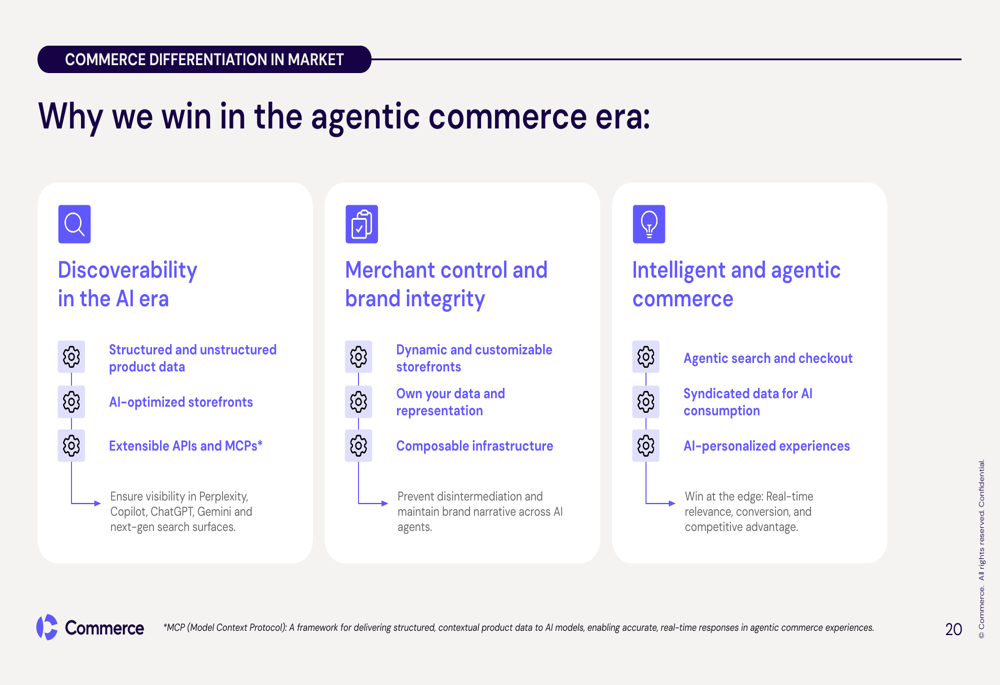
The presentation included an extensive AI glossary defining terms like "agentic checkout," "agentic discovery," and "buyer agent," underscoring the company’s focus on educating stakeholders about these emerging concepts and its readiness to capitalize on them.
Looking ahead, BigCommerce highlighted upcoming initiatives including self-serve adoption for small businesses in late 2025 and early 2026. This aligns with comments from the Q1 earnings call where the company mentioned plans to launch BigCommerce payments in early 2026.
Financial Analysis and Trends
Beyond the headline metrics, BigCommerce’s presentation revealed significant improvements in operational efficiency. The company has reduced non-GAAP operating expenses as a percentage of revenue across all major categories:
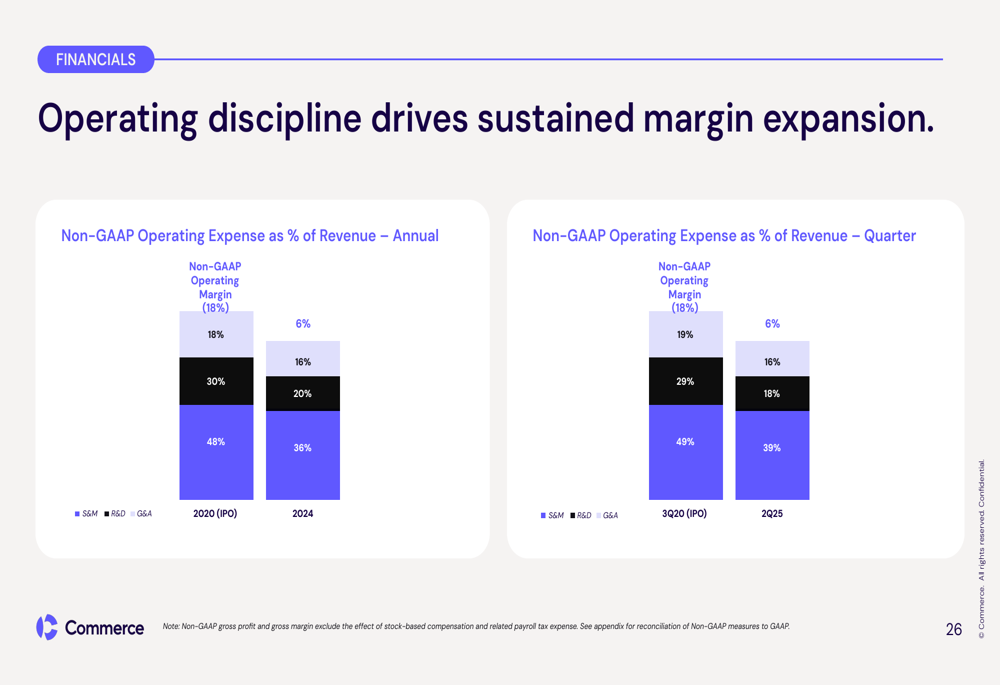
Revenue growth patterns show a more complex picture. While the company has achieved a 17% CAGR in total ARR since IPO, recent quarterly growth has been more modest. The presentation highlighted accelerating revenue growth in certain segments:
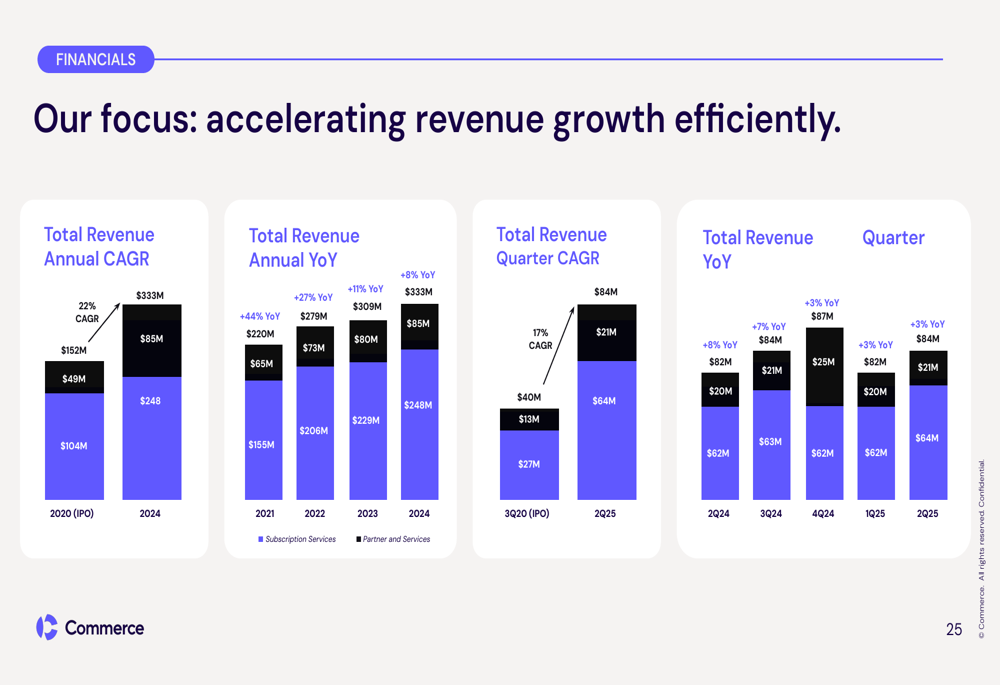
Operating cash flow has shown consistent improvement, reaching $14 million (16% margin) in Q2 2025 compared to negative $14 million (-20% margin) in Q2 2022:
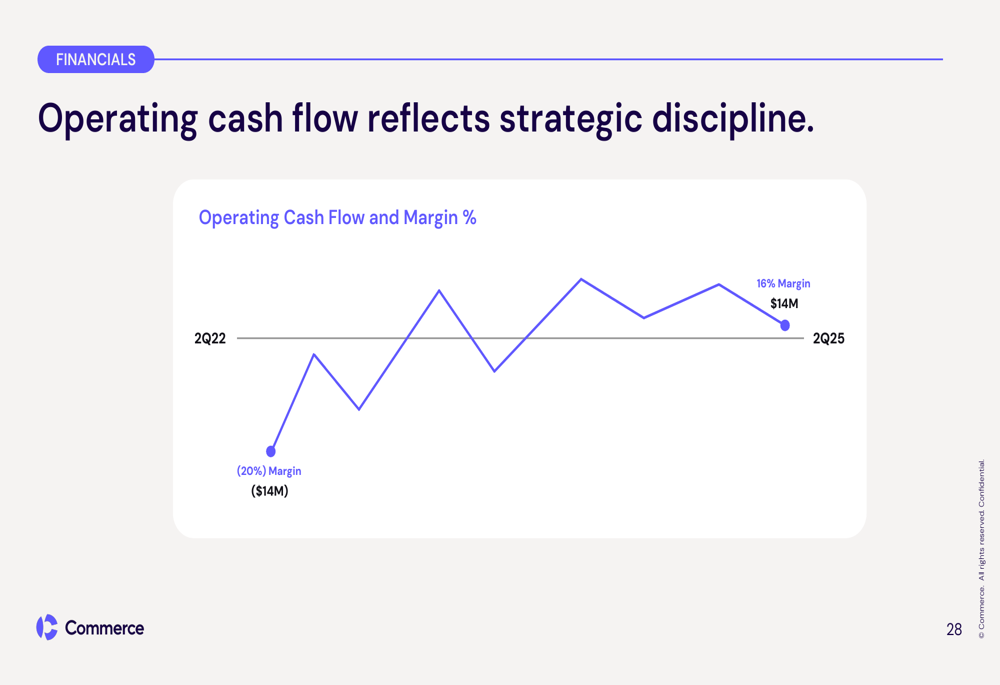
These financial trends suggest BigCommerce is prioritizing profitability and operational efficiency while maintaining moderate growth. This approach appears to be gaining investor confidence, as evidenced by the positive premarket stock movement following the results.
The company’s strategy of focusing on higher-value enterprise customers while improving operational efficiency appears to be yielding results, though challenges remain in accelerating overall revenue growth in a competitive e-commerce platform market. BigCommerce’s investments in AI capabilities and positioning for "agentic commerce" represent its bet on future growth drivers as the digital commerce landscape continues to evolve.
Full presentation:
This article was generated with the support of AI and reviewed by an editor. For more information see our T&C.
